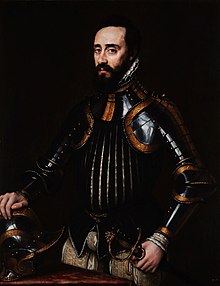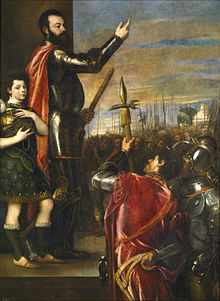Alfonso d'Avalos

Alfonso (III.) D'Avalos , also Alonso de Ávalos (in Spanish), with full name Alfonso d'Avalos d'Aquino d'Aragona (born February 25, 1502 in Ischia , † March 31, 1546 in Vigevano , province of Milan ) was an Italian prince - including Principe di Francavilla and Principe di Montesarchio - came from the originally Spanish noble family Avalos and was one of the most important generals of Emperor Charles V. In 1529 he became lord of Ischia and Procida and was imperial between 1538 and 1546 Governor of Milan and Captain General (Commanding General) in Italy.
origin
Alfonso came from the originally Spanish line d´Avalos, which had risen to become one of the most powerful noble families in the Kingdom of Naples and led the family name d´Avalos d´Aquino d´Aragona - extended by the names of important families of female ancestors (or his wife) .
He was a son of Inigo / Innico II. D'Avalos d'Aquino, 1st Marchese del Vasto, Conte di Monteodorisio († September 30, 1503) and his wife, Laura Sanseverino , from the house of the Pricipi di Bisignano .
Orphaned when he was young, he was brought up by his aunt, Costanza d´Avalos, Princess of Francavilla , Countess of Acerra and Governor of the island of Ischia . She was famous not only because of her cultivated court in Ischia and well-known poets as a patron, but above all because, as the woman in 1503, she had successfully defended the island of Ischia against forty French galleys for four months.
Alfonso was shaped by her and by his eldest cousin, the famous imperial general Ferdinando Francesco d'Avalos (* 1489/90, † 1525), the Marquis of Pescara, who was the governor of the Duchy of Milan and viceroy of Sicily . Alfonso inherited his title in 1525 and also succeeded him as commander of the imperial troops. He himself was entitled Principe di Francavilla (south of Pescara , in the province of Chieti ), Principe di Montesarchio (in the province of Benevento ), Marchese del Vasto (in the province of Chieti on the Adriatic Sea ), Marchese di Pescara (in the province of Pescara in the Abruzzo region ) and Conte di Monteodorisio (in the province of Chieti), was grandee of Spain and knight of the Order of the Golden Fleece .
Military career

Alfonso joined young under his cousin Fernando Francesco d'Avalos into the military service and fought under him against the French and Venetians and participated in several campaigns of Emperor Charles V in part.
In 1522 he fought in the Battle of Biccoca and distinguished himself during this campaign in the conquest of Lodi and in the occupation of Genoa . As the commander of a division of the Italian infantry, he took part in the unfortunate campaign in Provence in 1524 and fought in the siege of the city of Marseille . During the retreat he was temporarily given command of the imperial infantry by his uncle, the Marquis of Pescara, which Alfonso successfully commanded during the retreat from Acqui to Pavia .
Alfonso also took part in the important Battle of Pavia on February 24, 1525, commanding the vanguard of the imperial army, which consisted of 1,500 lancers and as many crossbowmen. His initiative played an important role in this, since with these forces in Pavia he made a breach in the wall of the Parco Mirabello and penetrated where the French had holed up. He successfully attacked the left wing of the opposing army and subsequently resisted the counterattack of the gendarmerie and the French nobility - which was personally commanded by King Francis I - until the main imperial army was able to victoriously end the battle, including the French king captured.
After this battle, Alfonso was commissioned by his cousin Ferdinando Francesco to occupy the Margraviate of Saluzzo in Piedmont . A task that he was able to successfully complete in July 1525.
On the basis of these achievements, on the recommendation of his cousin by Emperor Charles V on November 25, 1525, he was appointed captain general (supreme commanding officer) of the entire infantry of the imperial army in Italy. After the childless death of his cousin Francesco Ferdinando d'Avalos in the same year, Alfonso inherited his fiefdom and title. Three years later, as heir to his aunt Costanza d 'Avalos, he was able to add the titles Prince of Francavilla, Count of Montescaglioso and Count of Belcastro as well as the office of Governor of Ischia to his titles.
Together with the imperial general Antonio de Leyva (* 1480; † 1536) Alfonso forced Francesco II Sforza in 1526 , the last Duke of Milan of the Sforza family, to leave Milan and to renounce any initiative directed against the emperor.
During the campaign against the army of the League of Cognac created in 1526 at the instigation of Pope Clement VII (Giulio de 'Medici) (1523–1534) between the Papal States, France, Milan, Florence and Venice against Emperor Charles V , Alfonso tried to religious scruples prevented the sacking of Rome, the " Sacco di Roma " under Georg von Frundsberg, by intervening with the emperor and various commanders and did not want to take part.
In the years 1526–1528 he fought under Hugo de Moncada (1527 Viceroy of Naples ) and was captured in 1528 by the Genoese admiral Andrea Doria , who was then in the service of King Francis I of France.
In February 1529 he led the Spanish and Italian infantry from Rome to Naples to relieve the city besieged by the lieutenant general of the League, Odet de Foix , vicomte de Lautrec († 1528), Marshal of France since 1511. However, there were divergences between Alfonso and the imperial supreme commander, Philibert de Chalon , Prince of Orange († 1530), which led to the first French successes. Alfonso took over the command of the imperial army, which was used against the coalition troops of the French, Florentines and Venetians, who had carried the war to Apulia under the command of Renzo degli Anguillara, known as Renzo da Ceri († 1536) . During this campaign, which was particularly difficult for the coalition not least because of the support of the local population, Alfonso could not achieve any significant success, although he besieged Monopoli for two months.
In 1532 he took part in the army of Emperor Charles V in Austria on his campaign against the troops of the Sultan of the Ottomans, Suleyman I the Magnificent, when he made a second (unsuccessful) attempt to conquer Vienna. In 1535 he served as commander of the Spanish veterans during the emperor's Tunis campaign , hosted the expelled Tunisian king, Muley Hassan, on behalf of the emperor, commanded the vanguard of the attack on Tunis as captain-general and was the first to penetrate the city. In 1538 he was appointed third governor of the Duchy of Milan as the successor to Marino Caracciolo and there he also proved himself to be a promoter of writers and musicians until 1546.
In 1538 he represented Spain as ambassador at the enthronement of the new Doge of Venice, Pietro Lando .
During the Italian wars between the House of Austria and France, he commanded the imperial army from 1542–1546, and in August 1543 he succeeded in removing Nice from the siege by a French-Ottoman force under Khair ad-Din Barbarossa and François de Bourbon, Liberate Comte d'Enghien. In the Battle of Ceresole , however, he was defeated in an open field battle on April 11, 1544 by the French troops, who were under the command of his former opponent, François de Bourbon. A little later, on June 2, 1544, he managed to defeat an army of Italian mercenaries in the battle of Serravalle who were in French service and were commanded by Piero Strozzi and Giovanni Francesco Orsini, Conte di Pitigliano.
Family and offspring
Alfonso married on November 26, 1523 with Maria d'Aragona (* 1503; † November 9, 1568 in Naples), a daughter of Fernando d'Aragona, Duca di Montalto (who was an illegitimate son of King Ferdinand I of Naples [ 1458–1494]) and his wife, Castellana Folch de Cardona, daughter of Ramón de Cardona 1502 1st Duca di Soma, Viceroy of Naples (1509–1522) and Viceroy of Sicily (1507–1509). On the basis of this marriage he took the surname d'Avalos, d'Aquino d'Aragona.
Children:
- Innico d'Avalos d'Aquino d'Aragona († 1600), cardinal
- Gionanni d'Avalos d'Aquino d'Aragona ∞ an Orsini
- Beatrice d'Avalos d'Aquino d'Aragona ∞ Alfonso de Guevara
- Cesare d'Avalos d'Aquino d'Aragona ∞ Lucrezia del Tufo
- Carlo d'Avalos d'Aquino d'Aragona, 1st Principe di Montesarchio ∞ Sveva Gesualdo
- Francesco Fernando d'Avalos d'Aquino d'Aragona , Principe di Francavilla etc. ∞ Isabella Gonzaga
Individual evidence
- Oman, Charles (1937). A History of the Art of War in the Sixteenth Century . Londres: Methuen & Co.
- Gran Enciclopedia de España, 22 volumes, 11,052 pages, (1991), vol 3, page 1,109 ISBN 84-87544-01-0
- Jean-Pierre Vittu et Mika ben Miled: Histoire des derniers rois de Tunis d´après Marmol et Vermeyen, 2007, Carthage-Tunisie, ISBN 978-9973-704-05-4
- Genealogical Handbook of the Princely Houses, Volume XV. P. 538 f.
Pictorial representations
- Portraits of Titian from 1533 (with pages) and 1540 (address by Alfonso d'Avalos).
- On the cartons from the Tunis campaign designed by Jan Cornelisz Vermeyen in 1535 - during the battle - Alfonso is shown on carton 8 - and the tapestries made from it - when buying two Christian slaves.
See also
Web links
Individual evidence
- ↑ "Dizionario Biografico degli Italiani" 4th volume, p. 621, (1962) [1]
- ^ Gaspare De Caro, Avalos, Alfonso d ', marchese del Vasto; in Treccani, Dizionario Biografico degli Italiani - Volume 4 (1962) [2]
- ^ Gaspare De Caro, Avalos, Alfonso d ', marchese del Vasto; in Treccani, Dizionario Biografico degli Italiani.
- ^ Gaspare De Caro, Avalos, Alfonso d ', marchese del Vasto; in Treccani, Dizionario Biografico degli Italiani.
- ↑ Gaspare De Caro, Avalos Alfonso d ', Marchese del Vasto; in Treccani, Dizionario Biografico degli Italiani.
- ↑ Gaspare De Caro, Avalos Alfonso d ', Marchese del Vasto; in Treccani, Dizionario Biografico degli Italiani.
| predecessor | Office | successor |
|---|---|---|
| Marino Caracciolo |
Governor of Milan 1538–1546 |
Ferrante I. Gonzaga |
| personal data | |
|---|---|
| SURNAME | d'Avalos, Alfonso |
| ALTERNATIVE NAMES | d'Avalos, Alfonso III .; de Ávalos y de Aquino, Alfonso; de Ávalos, Alonso (Spanish); d'Avalos d'Aquino d'Aragona, Alfonso (Italian) |
| BRIEF DESCRIPTION | Italian nobleman and general |
| DATE OF BIRTH | February 25, 1502 |
| PLACE OF BIRTH | Ischia (island) |
| DATE OF DEATH | March 31, 1546 |
| Place of death | Vigevano |

